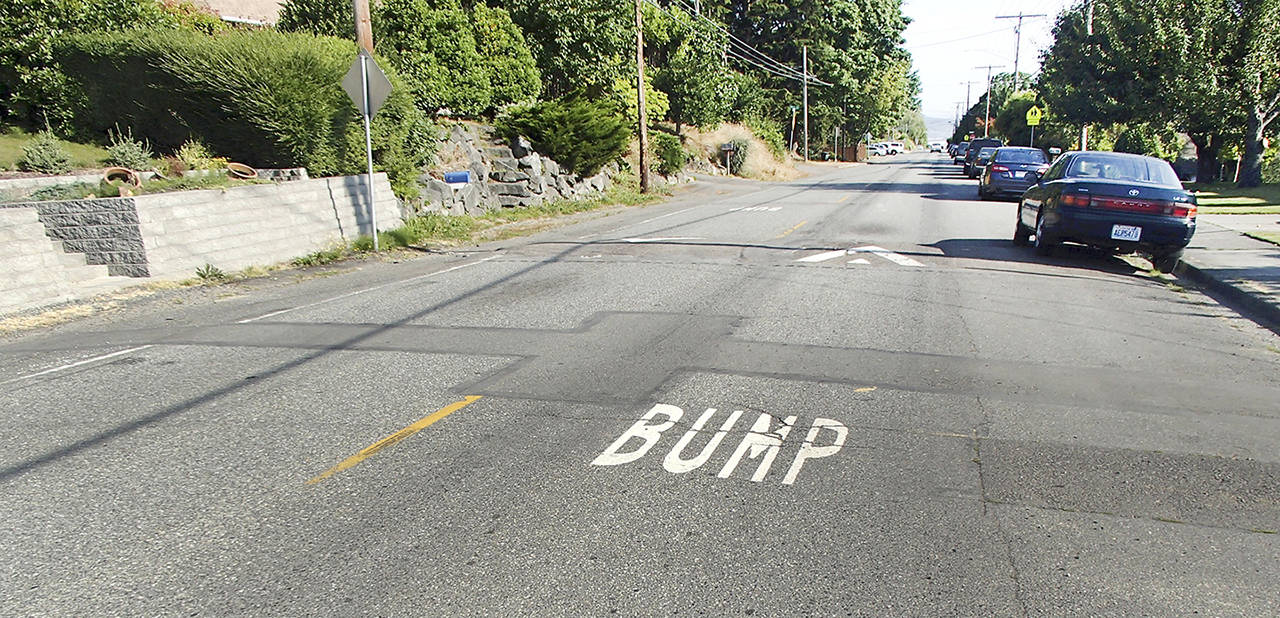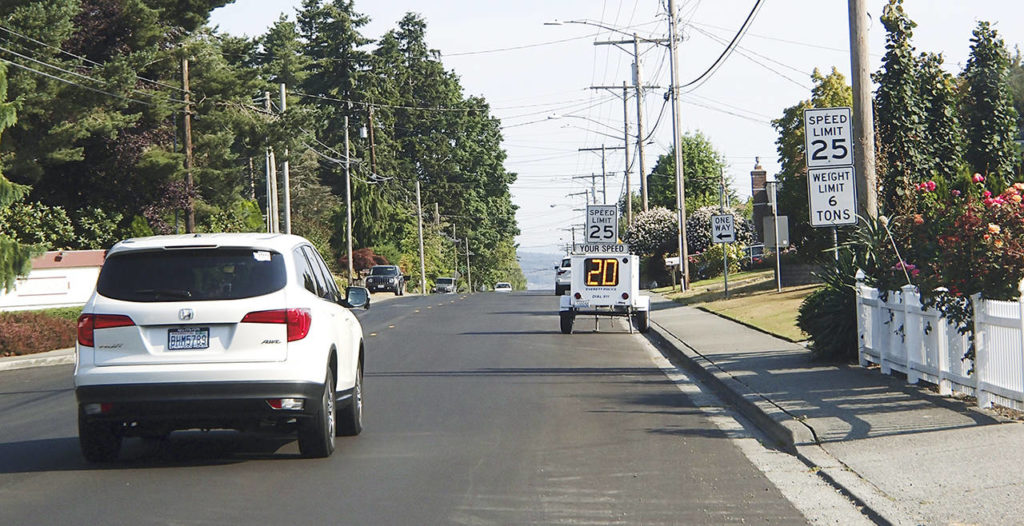Everett is getting rid of some bumps in the road as it wraps up its summer paving program — and we’re not talking just potholes.
Two speed humps have been removed from Federal Avenue in the Port Gardner Neighborhood as part of separate repaving projects. The most recent work, this summer, removed a speed hump near Forest Park Seventh-day Adventist Church.
That leaves just one remaining speed hump on Federal Avenue, in the 3900 block. That, too, will be removed when that stretch is repaved, which could be as early as 2020.
The practice reflects a shift away from speed humps across the country. Other local cities squashing the traditional bump include Edmonds, Marysville, Mill Creek, Monroe and Stanwood.
Everett offers a 14-point list of reasons, including slower response times for oversized emergency vehicles, conflict with bicycle lanes, noise and exacerbating pain for those with back problems.
No. 1 on the list, though, is that they are ineffective. Everett studies indicate the humps only have an impact of about 1 mph at most. Many drivers speed between humps to “make up for lost time.”
All that said, the “traffic calming” tool is slowly vanishing.
“In the case of construction, if they disappear, we don’t replace them. We’re not driving around targeting them, taking them out,” construction manager Mike Kangas said.
Speed humps were originally developed in Great Britain, according to a report from the Center for Transportation and Research at Iowa State University. (Not to be confused with speed bumps, which are taller and more common to parking lots.) In the United States, speed humps were first tested in 1979 in St. Louis. In 1983, California got on board, and the rise was on.
The slow decline has been happening for more than a decade.
But given the humps’ long history, drivers and residents often are surprised to see them gone.
Mixed feelings for residents
The city removed several speed humps on Grand Avenue in the Northwest Neighborhood during past repaving projects. Several residents reached out afterward, the majority to say thank you, engineer Tim Miller said.
Reactions on Federal Avenue have been more mixed.
Speeding is a big problem, according to residents up and down the street.
Drivers use Federal Avenue as a shortcut from Mukilteo Boulevard, near Forest Park, to get to other parts of north Everett. Some question the city’s finding that the humps were ineffective at slowing those drivers down.
Two schools are on that stretch, including Jackson Elementary. Drivers are known to ignore the 20 mph school zone limit, said Andrea Tucker, chairwoman of the Port Gardner Neighborhood Association. She worries about safety now that another speed hump is gone.
Forest Park Seventh-day Adventist Church is adjacent to where the speed hump was removed this summer. The campus includes a school. On sunny days, students and staff sometimes walk to nearby Forest Park. Staff are concerned.
“We have noticed an increase in traffic speed on Federal since the removal of the speed bumps,” said Kathy Marier, administrative assistant at the church.
At the other end of Federal Avenue, Marisa Burghdoff also worries about her kids’ safety. The family lives on the downhill stretch where there is no on-street parking.
“People go flying down the hill, and because the sidewalk is right next to the street it makes me super nervous with the kids, especially if they are riding bikes,” she said.
A speed hump used to be right outside the Burghdoff family’s front yard. It was removed in 2014 as part of a repaving project, before the family moved in. Burghdoff said she’d most like to see more buffer between the sidewalk and road. Barring that, she’d like the hump back.
Between the Burghdoff residence and the church, Ross Jameson lives next to the last remaining speed hump on Federal Avenue.
He parks one of his cars on the flat portion of the road between the hump and the curb to prevent drivers from driving around the obstacle. He doesn’t drive the vehicle much anymore. “I pay for tabs for it every year just to block that side,” he said.
Speed bumps aren’t perfect, Jameson said. Larger SUVs don’t have to slow down to clear them. And they can be noisy.
“But we need something,” he said.
Police have held emphasis patrols. A pair of officers on motorcycles used Jameson’s driveway for a recent enforcement campaign. They were busy. But the speeders, some of them chronic offenders, just keep speeding, Jameson said. “They don’t care (that it’s a neighborhood). They’re trying to get ahead of traffic.”
“It kind of ruins our city,” he said.
Slowing down, but not stopped
Not everyone is getting rid of the speed hump.
Lynnwood still uses them. “We continue to see their effectiveness in our community,” spokeswoman Julie Moore said.
Mukilteo also has speed humps, but only if the area of concern meets a list of requirements, including requests from multiple property owners.
Mill Creek has added temporary speed bumps at five locations as part of its 35th Avenue SE rebuild project to slow drivers through detour routes.
Bothell considers speed humps a tool, spokeswoman Barbara Ramey said. “But we haven’t installed any in more than 15 years.”
Indeed, while several cities leave the option on the table, they usually choose other methods to slow traffic.
Edmonds has a popular traffic calming program. In the past two years, the solutions have involved radar feedback signs, which display a driver’s current speed compared to the speed limit.
Other alternatives gaining popularity across the county are “speed tables,” which are wider and often used at crosswalks. There also are “speed cushions,” which have gaps for emergency vehicles to pass.
Newer road designs also include elements like “chokers” and “chicanes,” which bump out curbs to narrow the road, encouraging drivers to slow down.
In Marysville, the primary tool since 2014 has been traffic circles.
“Traffic circles have proven to be effective in reducing traffic speeds, particularly for speeds greater than 10 mph over the limit,” engineer Jesse Hannahs said. So far, the city has installed 18 traffic circles, with more planned depending on the budget.
Keep calm, drive on
Most cities and Snohomish County have traffic-calming programs, which offer a way for neighborhood residents to request help with speeding issues.
Those interested should contact their local public works department. For unincorporated areas of Snohomish County, go to snohomishcountywa.gov/502/Neighborhood-Traffic-Calming-Program, or call 425-388-6420.
Talk to us
> Give us your news tips.
> Send us a letter to the editor.
> More Herald contact information.


























